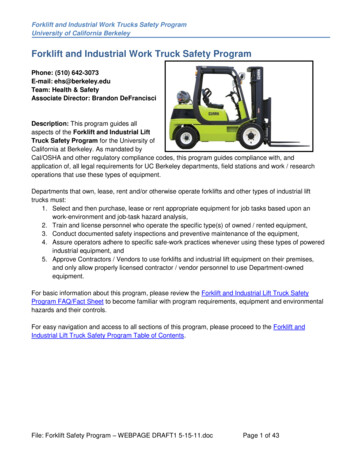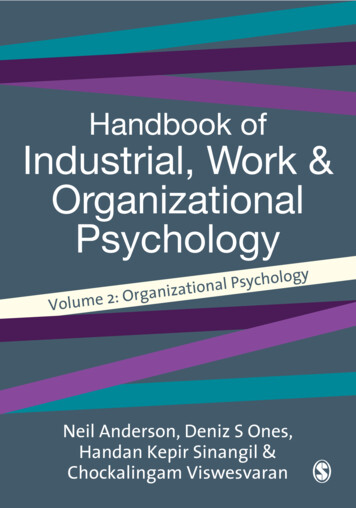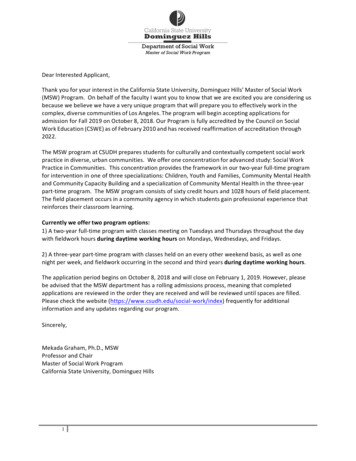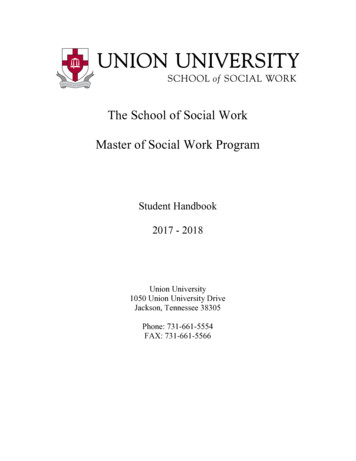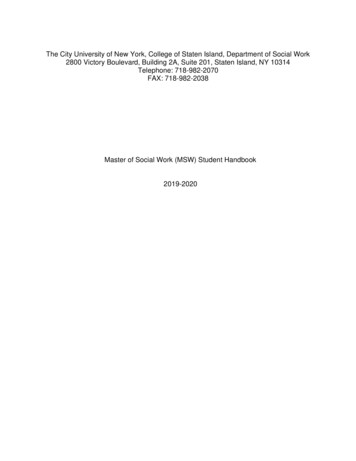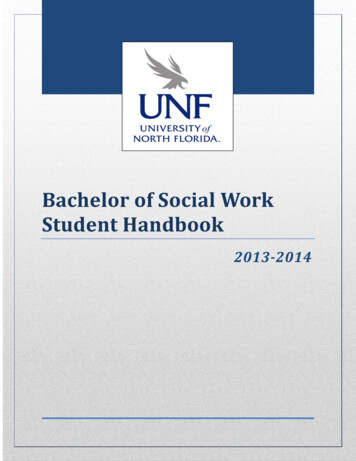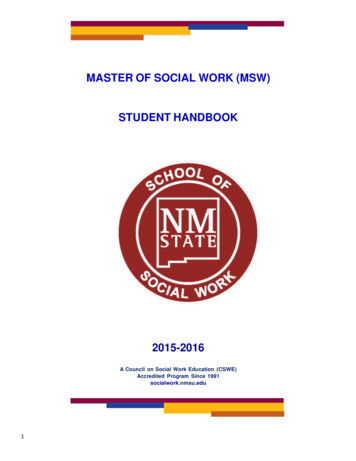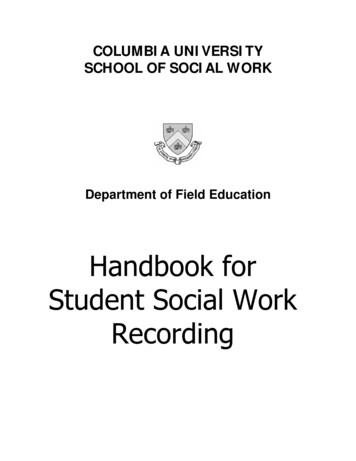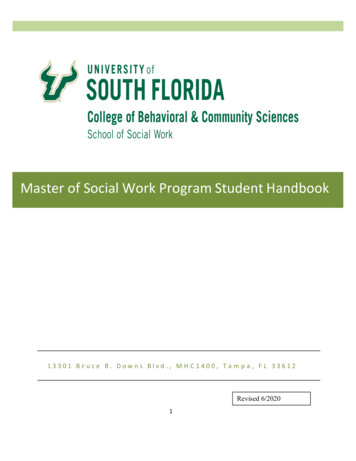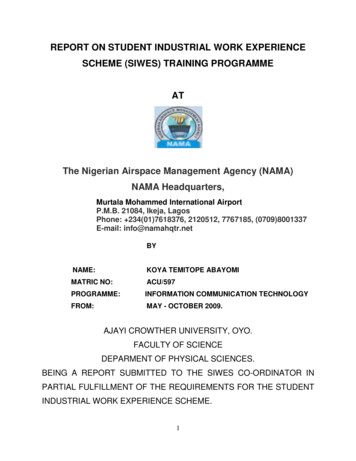
Transcription
REPORT ON STUDENT INDUSTRIAL WORK EXPERIENCESCHEME (SIWES) TRAINING PROGRAMMEATThe Nigerian Airspace Management Agency (NAMA)NAMA Headquarters,Murtala Mohammed International AirportP.M.B. 21084, Ikeja, LagosPhone: 234(01)7618376, 2120512, 7767185, (0709)8001337E-mail: info@namahqtr.netBYNAME:KOYA TEMITOPE ABAYOMIMATRIC NO:ACU/597PROGRAMME:INFORMATION COMMUNICATION TECHNOLOGYFROM:MAY - OCTOBER 2009.AJAYI CROWTHER UNIVERSITY, OYO.FACULTY OF SCIENCEDEPARMENT OF PHYSICAL SCIENCES.BEING A REPORT SUBMITTED TO THE SIWES CO-ORDINATOR INPARTIAL FULFILLMENT OF THE REQUIREMENTS FOR THE STUDENTINDUSTRIAL WORK EXPERIENCE SCHEME.1
DEDICATIONI dedicate this report first and foremost to Almighty Godwho has been there right from the beginning to this verypoint. Special dedication also to my ever supportiveparents, for their relentless support and compassiontowards me during the course of my six months SIWEStraining.To God is the glory.2
ACKNOWLEDGMENTWith a deep sense of appreciation, respect and gratitude, Iwant to say a big thank you to my parents, brothers, sistersand other relatives and non relative friends for their caringattitude and support from the beginning of my pursuit forB.Sc degree in Information Communication Technology tothis point.I also want to express my appreciation to my immediatesupervisors, Mr. Ifeanyi Ogochukwu, (ICT Manager,NAMA) and Mrs. Onusi (Information Technology ServicesManager (ITSM), NAMA), for their intellectual supportduring our work together.Not forgetting the other ICT Department Management teamof, Mr Femi Opeyori, Mr Ernest Aigbangbe, Mr. Charles Ibe,Mr Emmanuel Adeniran and my other IT colleagues.My sincere appreciation also goes to everyone that has beenby me all this while. A Big thanks!!!KOYA TEMITOPE ABAYOMI3
Table of ContentsTitlePageCover Page1Dedication2Acknowledgement3Table of Contents4Chapter One: Introduction5-7Chapter Two: Nigerian AirspaceManagement Agency8-11Chapter Three: Activities at ICT Department12-13Chapter Four: Skills and Knowledge Acquired 14-21Chapter Five: Problems EncounteredAt My Workplace22Chapter Six: Recommendation23Chapter Seven: Conclusion244
CHAPTER ONEINTRODUCTIONSIWES was established by ITF in 1973 to solve the problem of lack of adequatepractical skills preparatory for employment in industries by Nigerian graduates oftertiary institutions.The Scheme exposes students to industry based skills necessary for a smoothtransition from the classroom to the world of work. It affords students of tertiaryinstitutions the opportunity of being familiarized and exposed to the neededexperience in handling machinery and equipment which are usually not availablein the educational institutions.Participation in Industrial Training is a well-known educational strategy.Classroom studies are integrated with learning through hands-on work experiencesin a field related to the student’s academic major and career goals. Successfulinternships foster an experiential learning process that not only promotes careerpreparation but provides opportunities for learners to develop skills necessary tobecome leaders in their chosen professions.One of the primary goals of the SIWES is to help students integrate leadershipdevelopment into the experiential learning process. Students are expected to learnand develop basic non-profit leadership skills through a mentoring relationshipwith innovative non-profit leaders.By integrating leadership development activities into the Industrial Trainingexperience, we hope to encourage students to actively engage in non-profitmanagement as a professional career objective. However, the effectiveness of theSIWES experience will have varying outcomes based upon the individual student,the work assignment, and the supervisor/mentor requirements. It is vital that eachinternship position description includes specific, written learning objectives toensure leadership skill development is incorporated.Participation in SIWES has become a necessary pre-condition for the award ofDiploma and Degree certificates in specific disciplines in most institutions ofhigher learning in the country, in accordance with the education policy ofgovernment.5
Operators - The ITF, the coordinating agencies (NUC, NCCE, NBTE), employersof labour and the institutions.Funding - The Federal Government of NigeriaBeneficiaries - Undergraduate students of the following: Agriculture, Engineering,Technology, Environmental, Science, Education, Medical Science and Pure andApplied Sciences.Duration - Four months for Polytechnics and Colleges of Education, and Sixmonths for the Universities.The following are some of the objectives of SIWES:1.2.3.4.5.6.7.8.9.10.11.12.13.14.15.SIWES will provide students the opportunity to test their interest in aparticular career before permanent commitments are made.SIWES students will develop skills in the application of theory to practicalwork situations.SIWES will provide students the opportunity to test their aptitude for aparticular career before permanent commitments are made.SIWES students will develop skills and techniques directly applicable totheir careers.SIWES will aid students in adjusting from college to full-time employment.SIWES will provide students the opportunity to develop attitudes conduciveto effective interpersonal relationships.SIWES will increase a student's sense of responsibility.SIWES students will be prepared to enter into full-time employment in theirarea of specialization upon graduation.SIWES students will acquire good work habits.SIWES students will develop employment records/references that willenhance employment opportunities.SIWES will provide students the opportunity to understand informalorganizational interrelationships.SIWES will reduce student dropouts.SIWES Students will be able to outline at least five specific goals withseveral staff members by comparing performance with job duties anddevelop a draft plan with staff to accomplish performance needs, supervisionplan and rewards.SIWES Students will be able to develop a draft agency or project budget andwill be able to identify methods of obtaining revenue to support the budget.SIWES Students will be able to provide tools to use in prioritizing tasks ofan assigned project and create with staff a tentative schedule for completionbased on these tasks.6
16.17.SIWES Students will be able to develop a model policy that gives currentfront-line leaders the permission and expectation to work with other staff onconflict resolution and explain how this works to current front line leaders.SIWES Students will be able to describe different skills leaders can use toFoster commitment and collaboration with both internal and externalconstituents.The 6 months Students Industrial Work Experience Scheme (SIWES) whichis a requirement for the completion of my course of study, InformationCommunication Technology, was undertaken at the Nigerian AirspaceManagement Agency (NAMA) Headquarters. The Agency also has branchesat a regional office, the local airport, the international airport in Lagos andall functional airports in Nigeria. The Agency’s function is to manage theAirspace, as the name implies. The Agency occupies the control towers atthe airports, where the Air Traffic Control Officers manage the inflow,outflow and guidance of airplanes around the country’s airspace.I was an Industrial Attaché (IT) at the Information & CommunicationTechnology (ICT) Department.The Industrial Training was based on working with Personal Computers,servers, printers, laptops, switches, routers, hubs and computer peripherals. Theinstallation, repair, preventive maintenance and also auditing of these devices werepart of my job description.7
CHAPTER TWONIGERIAN AIRSPACE MANAGEMENT AGENCYThe Nigerian Airspace Management Agency (NAMA) P.M.B. 21084 has itsheadquarters located opposite the domestic terminal of the Murtala MohammedAirport Ikeja with outstations/ branch offices located in all the various airports inthe country.BRIEF HISTORY OF NAMA:On August 31st 1995, the Federal Government announced the restructuring of theaviation industry through the merger of the former Nigerian Airport Authority(NAA) and the Federal Civil Aviation Authority (FCAA) to form a neworganization called the Federal Airport Authority of Nigeria (FAAN) via decreeNo. 9 of 1996.With effect from 1st of January, 2000, another restructuring took place;FAAN was de-merged to give birth to Federal Airport Authority of Nigeria(FAAN), Nigerian Airspace Management Agency (NAMA), and the Nigerian CivilAviation Authority (NCAA).The old staff of FCAA and its function(s) was movedto NAMA, which now became an organization of its own via the decree No.48 of1999.The organization operationally took effect from 1st of January 2000.NAMA was charged with the responsibility of ensuring Aircraft safety withinthe Nigerian airspace as well as the provision of facilities for safe take-off andlanding of any aircraft. These facilities include Distance S),NonDirectionalBeacon(NDB),Very high Omni directional Radio range(VOR),Radio DirectingAnd Ranging(RADAR) etc. Provision of these facilities must be in line with theInternational Standard And Recommended Practices (ISARP) as stated by theInternational Civil Aviation Organization (ICAO).Vision of NAMA: To promote the safety and economic well being of our airspace.To make the airspace rank amongst the best, in Africa and indeed the world over.8
Some functions of the organization include To provide safe and functional air traffic services that will meet internationalstandards. To increase air traffic control (ATC) capacities in order to manageincreasing air traffic volumes and at the same time reduce delays. To provide ATC services in the country, including visual and non-visualaids, aeronautical telecommunication services, to enable publictransportation, private business and military aircraft fly as far as practicableand safe as possible. Ensure an effective co-ordination in the use of the Nigerian airspace in linewith established standards and procedures. Provision of adequate facilities and personnel for efficient airspacemanagement services and effective security of navigational aids outside theairport parameters. Installation and effective maintenance of air navigational facilities in all theairports and air routes Restructuring of the routes for positive area airways control. Provision of total radar coverage for Nigeria’s airspace. Liaise with international organizations for improvement of air navigationservices. To hold meetings with the Armed Forces on Nigeria’s internationalobligation as they relate to civil and military co-ordination.The Organizational Structure of NAMAThe Organizational structure of NAMA has the Federal Ministry of Transport,State Ministry for Air Transport as its supervisory body, to whom the Board isresponsible. The Managing Director is a member of the board and he reports to theboard. The structure of the organization is in a form where there are 22 Airports inthe country and each airport is headed by an Airspace Manager who is responsibleto the Managing Director. Each Airport has its staff responsible to the AirspaceManager.There are seven (7) Directorates with the Executive Directors responsible to theManaging Director. These Directorates of the organization are:1. Directorate of Human Resources (DHR)9
2.3.4.5.6.7.Directorate of Finance (DOF)Directorate of Air Traffic Services (DATS)Directorate of Safety Electronics Services (DSES)Directorate of Corporate Affairs/Legal Services (DCALS)Directorate of Aeronautical Information (DAIS)Directorate of Commercial and Business Development (DCBD)Other service departments are: Audit, Information and CommunicationTechnology (ICT), Quality Assurance and Safety Management, Planning/ProjectManagement, which are directly under the supervision of the Managing Director.10
ORGANIZATIONAL STRUCTURE OF THE NIGERIAN AIRSPACEMANAGEMENTAGENCYFederal Ministry of TransportationProtocolManagement BoardGM QualityAssurance/SafetyManagementManaging Director/CEInformation andCommunicationTechnologyGM Logistics andProcurementGM AuditDirector municationsGMAeronauticalInformationServicesGM ChartsServicesDirector of SafetyElectronic ServicesGM S)GMElectronicCommunicationsDirector of AirTraffic ServicesGM PlanningandTechnicalEvaluationDirector ofCommercial andBusinessDevelopmentGMCommercialGM FinanceGM BusinessDevelopmentGMAccountsand StoresGM CustomerServices/ServicomGM Searchand rector ofFinanceGM LagosGM P/HarcourtGM AbujaGM Kano11Director ofHumanResourcesDirector ofCorporate Affairsand LegalServicesGM HumanResourcesGMAdministrationsGM LegalServicesGM PublicAffairsGM PRS
CHAPTER THREEACTIVITIES AT ICT DEPARTMENTMost of the departments in Nigerian Airspace Management Agency rely oninformation and this information can be passed on more reliably and faster throughthe use of computer systems and other computer accessories like the internet,intranet e.t.c. Thus there is the need to have a department or a section within theorganization that will see to the procurement, distribution, installation, and overallmaintenance of these computer systems and their related accessories. This is wherethe ICT department of NAMA comes into play.The ICT department is located directly under the Managing Director (MD) and isheaded by the ICT Manager. The ICT department is further divided into 4 arms:Helpdesk: This part of the ICT department acts as a call centre. Users in theorganization call the Helpdesk when they have any challenge with their computers.The Helpdesk receives user’s calls, logs the calls in a CALL SHEET and forwardsthe challenge to the appropriate arm of the department that will resolve the call.After the call is resolved, the person who resolves this call must get in touch withthe Helpdesk, informing them that the challenge has been resolved.Network Communications (Netcom): This arm of the department is involved inresolving challenges that are related to computer networking within the Agency.This concerns the local intranet and internet connections. It also manages theconnections between the Agency’s headquarters, regional office, local andinternational airports.Business Operations Support (BOS): This arm of the department is involved inresolving challenges that are related to the hardware and software components ofthe computers used within the Agency. The BOS handles procurement andinstallation of new computer systems, repair of existing computer systems andpreventive maintenance of the computer systems.Training Centre: this arm of the department is responsible for training theagency’s staff and IT student on utility programs that are relevant for businessoperations in the agency. Staffs and IT students are trained to use the computer.They also train staffs on how to use some dedicated systems/workstations and new12
programs for the day to day running of the agency. The training centre is the venuefor software development and engineering, the dissemination of knowledge andideas based on the world of the ever growing and improving software andhardware architecture.ICT department has an office which is the helpdesk where you can find the ICTmanager, Information Technology Service Manager (ITSM) and a handful of ITstudents.The BOS and NETCOMS arms of the department are situated in the centralworkshop with two supervisors overseeing the activities going on there. This iswhere the repair, maintenance and general fixing of computers, computer resourcesand networking. Here the IT student, under the supervision of two IT personnel,resolve problem that are brought in from other departments. When this is done, thestatus of the problem (either it is resolved or work is still in progress) is loggeddown both at the helpdesk and in the workshop. Logging down these cases is donefor record purposes. This will enable the ICT department know which problems arepredominant in the organization, which user need to go for IT courses and ingeneral try to find solution to lingering problems Then the computers and/or itperipheral are taken back to their various users. Also there are cases where theseproblems do not need to be brought to the workshop and can be resolved in thevarious offices in which the complaints come from.13
CHAPTER FOURSKILLS AND KNOWLEGDE ACQUIREDThen I was assigned to the BOS arm of the department, were I was taught on theidentification various component of computer hardware, e.g. hard disk, floppydiskette, random access memory (RAM), removing and replacing of thesehardware components, installation of various software, how to connect variousdevices (printers and scanners) and other computer peripherals.Some of the computer components that I familiarized myself with includes: The Motherboard: this is a thin flat piece of circuit board (usually of greenor gold color). Everything in the Computer connects, directly or indirectly,to the motherboard. It contains a number of special sockets that acceptsvarious component of the computer.Components on a motherboard14
RAM: The random access memory stores programs and data currently beingused by the CPU. It is measured in bytes, which is measured in megabyteswhere you have millions of bytes of RAM. The average PC usually hasbetween 32 megabyte/128 megabyte to 1 gigabyte of RAM (modern PCsmay have several megabytes). The RAM has a socket that allows it to beplaced on the motherboard.A picture of a typical PC RAM Floppy drive: The floppy drive enables you access floppy diskettes. Thereare two types of floppy drives; 3.5 inch floppy drive and the, (rarely used)5.25 inch floppy. The floppy drive connects to the computer via a 34-pinribbon cable which in turn connects to the motherboard (floppy controller).They also have power cables that connect to the “power pack”. Hard drive: Hard drives stores programs that are not currently being usedby the CPU. Like the RAM, hard drive capacity is measured in megabytes.A typical PC hard drive stores much more data than the RAM and thus canrange from 500 megabytes (in very old systems) to more than 75 to 100gigabyte. Like every other component of the PC, the hard drive hasconnectors called the EIDE cables. They also have power cables.15
A hard disk DVD/CD ROM Drive: The DVD/CD ROM drives enables access to DVDand CD ROMs. Some PC’s come with recordable and or rewritable CD andDVD. They also need power supply via the power cable. Connectors: These connectors (often called ports) allows for connection ofother components of the computer. We have the DB (printers, monitor), DIN(keyboard, mouse), Centronics (printer), RJ (network interface card,modem), BNC (network interface cards), Audio (speakers, headphones) andUSB (keyboards, mouse, printers, disk drives etc) connectors, each with itsown type of device that it connects to the computer. Cooling system: Cooling system consist of the two or more fans. One fanfor the system (CPU), and one for the processor. The CPU will operate morereliably and will have a longer life span if the cooling system is workingproperly. Power supply: The power supply distributes power to the motherboard andother component in the CPU.16
I was also shown how to format a hard disk, installing and configuring operatingsystem on a formatted system, downloading and installation of necessary driversand installation of other application software.I was placed under the supervision of Mr. Charles Ibe.In the following month, I was assigned to the NETCOM arm of ICT departmentunder the supervision of Mr. Emmanuel Adeniran, where I learnt differentnetworking topologies, worked with different networking devices like the hubs,switches, routers and network printers. I got
experience, we hope to encourage students to actively engage in non-profit management as a professional career objective. However, the effectiveness of the SIWES experience will have varying outcomes based upon the individual student, the work assignment, and the supervisor/mentor requirements. It is vital that each
